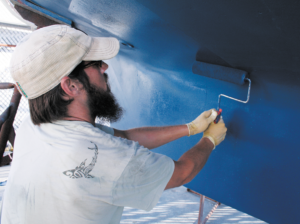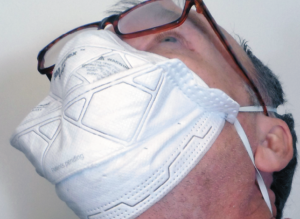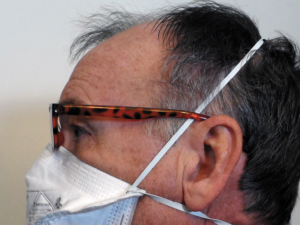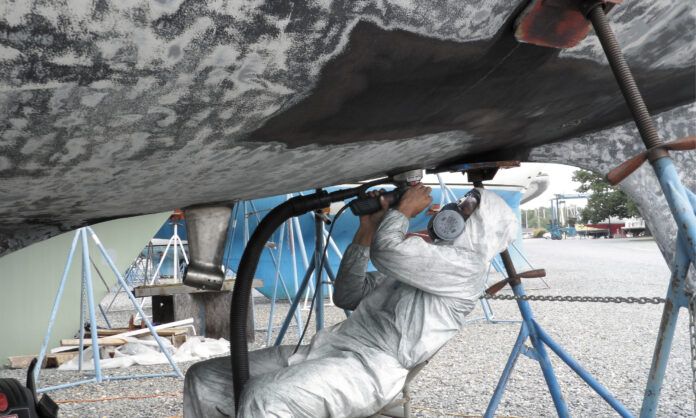One look at the safety data sheet for an antifouling paint, and a quick listen to the controversy surrounding the effects of antifouling paint on marine life, and you should be scared silly when it comes to painting and sanding. It contains solvents, paint resins, and marine toxins meant to repel marine life. But how hazardous is the stuff, really, and what protective equipment is needed?
Although there are no comprehensive studies concerning DIY practices, we found studies of ship painting and sandblasting. To fill in the gaps, we built a mathematical model of sanding and spraying practices, and then compared its predictions with industrial studies. We stand by the results, but recognize that every situation is different.
PAINTING
Inhalation hazards with paints and solvents are severe when spraying and in confined spaces. The first distributes the solvent into the air, and the latter prevents air currents from moving it away. Commercial shipyards have been studied, and sure enough, vapor concentrations inside ships can be high, and multiple painters on the outside can exceed OSHA limits. But what about a single DIYer rolling paint on the side of his boat in the open air?

Let’s assume that a single coat of paint uses 10 kilograms of a solvent-based, 60-percent copper paint and takes 1 hour to apply. We’ll assume that 50 percent of the solvent evaporates in that time period, and the average air flow past the boat is 1 meter/second across a 10 meter by 2 meter area (72,000 cubic meters of air). Unlike spraying, which concentrates much of the vapor around the painter, the drying process is spread all along the hull.
There is also a theoretical exposure to copper spray coming off the roller. When spray painting, studies show exposure can exceed the limit by three times. Although studies vary, painting with a brush or roller is thought to lower breathable mist exposure by 7 to 30 times, reducing copper exposure below harmful levels if applied with a brush or roller.
We calculated the average concentration of each solvent constituent, compared it to the Occupational Safety and Health Administration’s permissible exposure limits (PEL), which are averaged over 8 hours, and found exposures ranged from nil to 0.4 percent of the OSHA limit, and totaled only 0.8 percent of the OSHA daily limit. Yes, you will be able to smell the solvent on the downwind side, but if you work with the wind at your back and move to windward, the exposure could be even less.

Do we wear organic vapor masks when painting? By working from leeward to windward, and if there is any breeze at all, it is not generally needed (unless we are working in the cabin or spraying).
If the boat is tented and ventilated with a forced filtrations system, vapor levels can rise near OSHA’s permissible exposure limits. If you were working in there all day, an organic vapor respirator would be mandatory.
Spray painting will push the exposure to 5 to 10 times the OSHA PEL, and a supplied air respirator is probably the right call for all-day work. Supplied air respirators provide a higher protection factor, and carbon canisters won’t last an hour at those levels.

SKIN EXPOSURE
What about skin exposure to paint? The solvent exposure to arms and legs is far too low to consider. Our hands will be over the limit, so we always wear impermeable gloves, generally examination gloves under snug-fitting coated work gloves (for a better grip).
As for paint drips on the arms and legs, all that is required is that it stays off the skin. Unless you are a sloppy painter indeed, long sleeves and long pants are sufficient. Tyvek suit is not needed. I find work clothes or coveralls far more comfortable than Tyveks, and if you don’t have something old, thrift stores are good. Or just buy some Dickies or Carhartts and they will last a lifetime of infrequent use. On the other hand, you can throw the Tyveks away. A hat keeps paint out of your hair and a head sock keeps it off your face and neck, though you will sacrifice comfort in a warmer climate.
SANDING AND BLASTING
Recreational boatyards have not been rigorously studied, but sand blasting in commercial yards has been. Here are some of the concerns when sanding:
COPPER EXPOSURE
Dried and aged paint has none of the solvent or uncured paint resins that wet paint has. Although potentially irritating and not great to breathe, OSHA has not assigned PELs to what is considered a nuisance dust. Additionally, about 75 to 90 percent of the copper and zinc have leached from the paint by the time it loses its effectiveness. The percentage copper present in the used commercial sand blasting grit averaged 0.2 percent copper. The old paint layers collected contained an average of 10.8 percent copper, a fraction of the original paint. Clean grit contained only 0.0012 to 0.0028 percent copper.
We did the same math for copper that we did for solvents, but changed the assumptions. We assumed the copper will be released only in the area right in front of the worker, and that only one square meter area of air flow would disperse the dust from that area.
We assumed it would take 16 hours to remove that same coat of paint, that only 20 percent of the original copper is still present, and a vacuum sander captures 75 percent of the dust. We then modeled sand blasting, assuming the removal was 6 times faster with no dust recovery.
We came up with about 1.3 times the OSHA PEL for vacuum sanding, but we believe it might be several times higher when working under the hull. A well-fitted N95 mask can reduce that to less than 10 percent of the limit. If the boat is tented and fitted with a forced air filtration system, the concentration goes up to 3 to 5 times the OSHA limit, but an N95 mask can bring this safely below the permissible limits.
The environment of the sand or soda blaster is much more concentrated, ranging from 30 to 50 times the OSHA limit. A blaster will wear a positive pressure supplied air helmet, with protection efficiency approaching 100 percent. Worn and operated correctly, studies show that his breathing air should be in compliance with the standard, though it can be close and fit testing is vital. An N95 mask is sufficient for assistants (pot men) in an open air environment and this is supported by other field studies.
ZINC EXPOSURE
Zinc, also used in antifouling paints, has an OSHA PEL (15 μg/m3). Zinc is not very toxic to people. You can buy zinc pills in the vitamin department and the U.S. recommended daily allowance for zinc is 11 mg/day, as compared to that for copper—0.9 mg/day. But it can cause irritation to the skin, eyes, and lungs if you breathe too much. Zinc leaches more rapidly from antifouling paints than copper and less is used, so if you follow the precautions for copper, zinc won’t be a risk.
The study of sandblasting exposure also measured concentrations under workers’ Tyvek suits. The suits reduced exposure by 30 to 100 times that of an unprotected worker and to a level considered below concern, since skin is not a primary exposure path. Workers wearing fabric work clothes were considerably more exposed, but the results were quite variable.
So how does this clothing exposure compare to recreational antifouling dust exposure using a vacuum sander? There is no data, but the dust we see on people’s clothing is far less than sand blasters, but not trivial. At the same time, heat exhaustion when working in the summer in non-breathable Tyveks should not be overlooked. Long pants and long sleeves are recommended.
SAFETY GUIDE: TOXIC EXPOSURE LEVELS - BOTTOM PAINTING AND BOTTOM PAINT REMOVAL
| WORKER EXPOSURE | PETROLEUM DISTILLATE | XYLENE | TRIMETHYL BENZENE | ETHYLBENZENE | TOTAL** | COMMENTS |
|---|---|---|---|---|---|---|
| OSHA - PERMISSIBLE EXPOSURE LIMIT (PEL) | 400 ppm | 100 ppm | 25 ppm | 125 ppm | NA | Parts per million averaged over 8 hrs. |
| OPEN AIR | ||||||
| PERCENT OF DAILY PEL* | 0.2% | 0.8% | 0.9% | 0.1% | 2% | Respirator not required. |
| PERCENT OF PEL WHILE ROLLER PAINTING (1 HR.) | 1.7% | 6.7% | 7.5% | 0.4% | 16% | Respirator not required. |
| TENTED WITH FORCED AIR FILTRATION | ||||||
| PERCENT OF DAILY PEL* | 23.6% | 94.3% | 105.6% | 6.0% | 230% | Organic vapor respirator required for long periods of painting. |
| PERCENT OF PEL WHILE ROLLER PAINTING (1 HR.) | 188.6% | 754.6% | 845.1% | 48.3% | 1837% | Organic vapor respirator required. Full face respirator recommended to protect eyes from vapors and for better fit. |
| TENTED WITH FORCED AIR FILTER, SPRAYING | ||||||
| PERCENT OF DAILY PEL* | 165.1% | 660.3% | 739.5% | 42.3% | 1,607% | Organic vapor respirator required. Full face respirator recommended to protect eyes from vapors and for better fit. Spraying must be tented in virtually all yards. |
| PERCENT OF PEL WHILE SPRAY PAINTING (1 HR.) | 1320.5% | 5282.2% | 5916% | 338.1% | 12,857% | A worker painting for long periods needs a positive pressure supplied air respirator with a fit test. Fan would need to be explosion proof. Many hazards. This is beyond anything a DIY should try. |
| PERCENT OF OSHA’S DAILY (8-HOUR) EXPOSURE LIMIT (PEL) WHILE SANDING** | ||||||
| COPPER, VACUUM SANDING | Open air | Tented with forced air filtration | Tight-fitting N95 mask required for vacuum sanding. The actual value will be several times higher when you are under the hull and dust is falling on your head. | |||
| 130% of PEL | 368% of PEL | |||||
| average over 8 hrs. | average over 8 hrs. | |||||
| COPPER, SANDBLASTING | Open air | Tented with forced air filtration | Sand blasting requires the use of a positive-pressure supplied air respirator. Recent study shows that even with positive air supply, sandblasters are working very close to exposure limits. | |||
| 3,125% of PEL | 8,829% of PEL | |||||
| average over 8 hrs. | average over 8 hrs. | |||||
| *Estimated percentage of 8-hour permissible exposure limit (PEL) established by the Occupational Safety and Health Administration (OSHA). These numbers represent the calculated exposure to a solvent-based, 60-percent copper bottom paint while working for one hour (assumed job time) averaged over 8 hours. Assumed air flow in the work area is 1 meter/second. | ||||||
| **Assumes paint has 20% of its original copper content, vacuum collects 75% of dust while machine sanding, and no dust collection while sandblasting. | ||||||
Amask only works if properly fitted. Sure, the fabric may be capable of stopping 95 percent of the smallest particles, but if much of the air is going around edges through gaps, you’re fooling yourself and wasting your money.

1. Bend the nose piece to fit high on the bridge of your nose, up under your glasses if you wear them. It will be easier to breathe and it won’t interfere with the glasses if fitted closely.

2. Wear it snug. There should be a very slight dent where it presses on the skin or there will be no seal. Adjust the head or ear straps as needed. One size does NOT fit all.

3. Check for gaps. There should be no gaps under the chin or around the nose. If your glasses fog or you feel cool air around the edges when inhaling hard, turning your head, or yawning, the fit is poor.

4. Head straps vs. ear straps. Ear straps are more convenient around town and even in a hospital setting, where nurses must be able to remove a mask without touching their face. But over the head straps produce a much better fit.
Not all masks fit all faces. I had to try multiple brands of elastomeric respirators at my job until I found one that sealed properly. The duck-bill style N95 masks with head straps have the most adaptable fit.
Can you reuse them? In the infectious disease ward they are considered single-use, but for boatyard use they can be recycled until they no longer fit well or are hard to breathe through. In hot weather sweat is a problem; rotating between 2-3 masks really helps. After use, store it in a zip-lock bag, leaving the bag open to vent until the mask is dry.
What about cloth COVID masks? We use them for mowing the grass or raking leaves, but even grinding metal we can tell a big difference in efficiency compared to N95 masks. With a well-fitted multi-layer cloth mask of similar design we can smell the metal aerosol, but with an N95 mask, we smell nothing.
Elastomeric masks provide better protection, but they are heavier and hot in warm weather. However, they provide better fit and can accept a wide variety of filter cartridges, including organic vapor cartridges required for painting. and N100 cartridges for extensive grinding. For more details on elastomeric masks, see ”Best Respirators for the Boatyard” and “Checking Respirators for Fit,”
PS October 2017.

This article was originally published on 20 April 2022 and has been updated.









































Thank you Drew,
Excellent article and i will print and put with my pre-season painting file.
We are preparing to sand and repaint the hull with Ablative Anti-fouling paint on our 06 41DS.
Could you, if possible do a comparison on full face sanding/painting Masks with replaceable filter cartridges on each side that have plexiglass glass or lexan face enclosures.
These have come down in price and offer full coverage over the mouth, nose and eyes. And are cleanable and reuse-able year over year with and offer the some of the best protection for painting and sanding.
Our Marina in RI requires us to tent and put down base tarps to prevent removed paint particles from being blown around the marina.
Our sander will be connected to a good vacuum source by hose as well to reduce as much as possible the collection of removed paint.
Thank you.
I’m assuming you mean full face respirators like the popular and well respected 3m 6900 series. Full face masks protect the eyes and provide a slightly higher (100 vs.95) level of respiratory protection due to the potential for better fit. Firefighters wear full-face respirators for these reasons. But there are a few things to consider.
Fit. Even more than half-face respirators, proper fit and protection require that the mask fit YOUR face. See “Respirator and Mask Safety,” March 2020. I wear 3M Scott masks because they fit my individual face better. Whatever you chose, do a fit test, and if it does not fit, return it.
Glasses. Fitting glasses to full face respirators is complicated, and wearing contacts, even with a full face mask, is not great when working around chemicals and dust. Name brands can be fitted with spectacle adapters, but this mean buying the adapter, another set of glasses, and they still don’t fit well. You cannot wear your regular glasses; the bows break the seal at the temples.
Heat. They’re great when it is bitter cold, but in the summer heat they are nearly unbearable. In industry we would have them equipped with supplied air that was cooled. I’m a big believer in efficient vacuum sander set-ups and keeping the breeze at my back when painting. Inside the cabin, a box fan in a deck hatch can be a life saver. Do not under estimate the risk of heat stroke. Read “Beat Boatyard Heat with Personal AC,” September 2020 for a review of body cooling.
I’ve spent many hundreds hours in full-face masks.